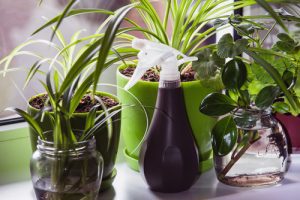Pests on Your House Plants
By Chris Williams on March 2, 2012.
When you bring potted plants that have been summering outside indoors in the fall, you risk bringing pests in as well. Pests like sowbugs, millipedes, and ants use plant pots as a home, living in the soil in the pot. Miscellaneous leaf chewers like grasshoppers or caterpillars may hitchhike in, unseen, on a potted plant. Fortunately, most of these pests will die once they are brought indoors to a drier environment.
But there is a larger group of plants that live on the plant and suck juices from it. This list includes spider mites, whiteflies, aphids, scale insects, thrips, and mealy bugs. These pests can continue damaging the plant indoors, and can even infest other indoor plants. Sometimes, plants are infested when they are purchased. The pests gradually build up on the plant for months, usually unnoticed until the plant begins to look sickly. Indoor plant pests can drop from the plant or wander or fly from the plant, and are sometimes mistaken for more serious household pests like bird mites, chiggers, dog ticks, or clothes moths.
How to Tell if Your House Plants are Infested
 Plant-sucking plants are usually found on the underside of the leaf or on the stem. At first glance, the plant may look fine. Bend down and turn over a few leaves. It will help to have a magnifying lens. You might find:
Plant-sucking plants are usually found on the underside of the leaf or on the stem. At first glance, the plant may look fine. Bend down and turn over a few leaves. It will help to have a magnifying lens. You might find:
- Insects or mites moving about, or tiny white eggs, pupal cocoons, or black fecal specks on the bottom of the leaves.
- Circular, flattened scale insects tightly attached to plant stems.
- Sticky droplets of “honeydew” exuded by the pests on the leaves, or a gummy feel on the surface below the plant. Ants may be attracted to the honeydew.
- Tiny whiteflies or fungus gnats flying off of the plant momentarily, and then settling back onto the leaves or soil.
- Thin webbing spun between the stems by spider mites. Look closely for tiny mites moving along the webbing.
- Stippled leaves covered with tiny yellow or white feeding punctures. Eventually the leaves will turn pale, coppery, or silvery, and may drop prematurely.
What Can You Do About an Infested House Plant?
There are many different treatments for infested plants, but they aren’t always successful. If you don’t particularly value the plant, or if it seems too far gone to save, it’s best to simply throw it out. If you want to try to save it, have a plant nursery or garden shop advise you on which insecticide products to try for your particular plant.
The best way to avoid bringing plant pests inside is to treat infested plants with a product labeled for use on house plants (insecticidal soap is a good choice) before you bring them in from outside. Once an infested plant has been inside, there’s always the possibility that other plants have been infested as well. Try to keep an infested plant from touching other plants.